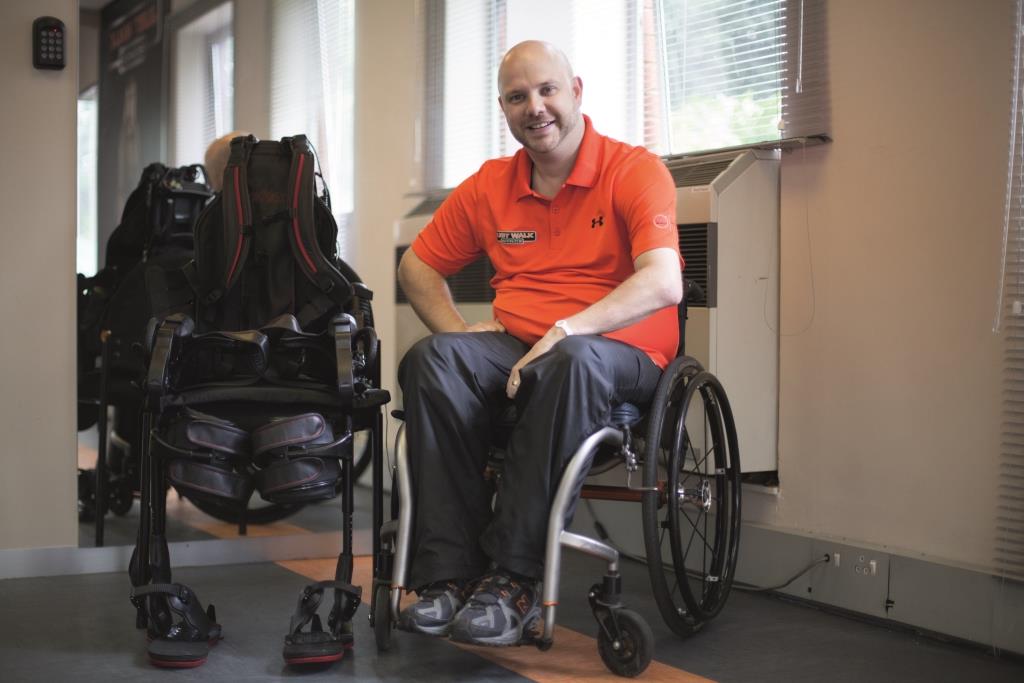Justin Smith pulled into the driveway after attending his mom’s surprise 60th birthday. His girlfriend at the time got out the car to fix the jammed gate when she suddenly screamed and ran inside the house.
“There was a knock on the window and I instinctively put the car into reverse and as I was reversing out, the hijackers started shooting at me,” says Smith as he draws a deep breath.
He lost control and crashed the car across the road. The hijackers came around, tossed him out the car and demanded his cell phone, wallet and jacket.
“As I was taking off my watch, I heard a gunshot and that was that. It was like a computer rebooting. As you hit the reset button it all goes dark and then everything starts coming back again.”

Loading...
Smith was airlifted to hospital where he received the devastating news. The bullet was lodged in his C6 vertebra and doctors could not operate as it would cause more damage. There was nothing they could do other than sticking a band-aid over the hole and hope for the best. Lying in the hospital bed, with no sensation from his shoulders down, reality began to set in.
“My mind was just racing: Where to now? What are we going to do? What’s my future going to be? Here I am, 28 years old, a week before my 29th birthday, now what?”
The months that followed were spent with councilors and physiotherapists in a rehabilitation center where Smith began to regain his strength. Smith’s unnatural positivity had one of the councilors concerned about his state of mind.
“At the end she said to me, ‘Did anyone explain to you there are certain steps that you go through in terms of acceptance?’ I said, ‘No, I obviously just went straight to the end.’”
His progress was slow yet consistent and as he began to move his arms, toes and legs the possibility of being able to walk again seemed promising.
Smith’s research led him to the Project Walk website, a company based in the United States (US) that specializes in spinal injuries. He relocated to California for nine months where he went through intensive rehabilitation and was able to walk with a walker. The trip cost him close to R1 million ($90,000). It was here that he met a friend who would introduce him to EKSO Bionics, a company that made a suit that could help paralyzed people walk. The battery-operated suit fits over people’s clothes and its motors control the steps of the person inside it. When EKSO came to South Africa in 2012, Smith went to test the so-called miracle suit. After only 30 steps in the EKSO, he was sold.
His dream of creating a center like the one he had seen in the US began to take shape when he bought an EKSO suit for R1.7 million ($153,000). He found a small office space in Johannesburg and created a gym with the equipment he had acquired over the years. Just Walk Bionics opened its doors in June 2012 and has since acquired more than 40 clients who have clocked in more than 80,000 steps in the EKSO suit. Sessions cost R900 ($80) for an hour in the suit and R370 ($33) for 45 minutes on the fitness equipment. The rehabilitation center’s aim is to bring hope to wheelchair-bound patients who never thought they would walk again.
“It’s like a light switch goes on. They’re apprehensive at first because they don’t know what’s going to happen. Then they go through all the steps and it stands them up into a bridge position and they stand there and they just look at the world from a totally different elevation,” he says.
Like any business, Just Walk Bionics has its fair share of challenges.
“The problem with the clients is that they are people with huge expenses already because of what their disability brings. Because we use new technology, medical aids don’t pay for it, they only refund a certain part of it.”
The company is currently running case studies to show medical aid companies the benefits of EKSO in the hope that they will fund it. The benefits include: relief of pressure sores caused by long periods of sitting, improved circulation and cardio vascular improvements.
Smith sees this project as part of his responsibility to give back to the community and to aid those who cannot afford to take a trip overseas or buy the suit.
“We had a client in Cape Town who spent £5,000 ($8,156) for just one week in the UK to experience the unit. I calculated that he could have walked for an entire year, three times a week for that same price.”
There is no doubt that Smith has achieved a lot. And even though he is wheelchair bound he has enough movement in his legs to drive his dream car.
“Of course you can image the response I got when I rolled in the dealership and said, ‘I’d like to look at one of your Range Rovers.’ The salesman brought one around and I wheeled to the side. I sat there for about five minutes in the doorway looking at everything. With my dad holding the door I managed to pull myself up into a standing position and onto the driver’s seat… Six months later, I bought one.”
“Nobody said life was going to be easy. Life is full of challenges and it’s how you approach those challenges that get you through it.”
Smith’s face lights up as he speaks of the future upgrades of EKSO and its ability to allow people to climb up ramps and stairs. It all sounds pretty impressive. One day you are told you will never walk again and the next you are climbing stairs. Imagine that.
Loading...
